Abstract
Calorimetric measurements have been made on the thermodynamics of the chain-melting phase transition of saturated diacylphosphatidylethanolamines, with chains containing 12-20 carbons, as a function of water content. The transition temperature, Tt, and the transition enthalpy, and entropy all decrease with an increase in water content; however, the effect on Tt lessens with an increase in chainlength. These results are compared with a theoretical description of lipid hydration in terms of the interlamellar water polarization (i.e., modified water structure) in the interbilayer region. The measured free energy, enthalpy and entropy of the transition and the transition temperature have an approximate hyperbolic tangent dependence on water content, infinity tanh (dw/2 xi), where dw is the interlamellar water-layer thickness and xi approximately equal to 0.25 nm is the water-order correlation length, in agreement with the theory. Auxiliary x-ray diffraction experiments yield results on the repulsive hydration forces between lipid lamellae consistent with the theory, and allow an estimate of the water orienting potential of the interface. The molecular origin of this potential is discussed in electrostatic terms, and the values of its associated molecular parameters are found to yield the right size of hydrational thermodynamic quantities. The theory thus provides an integrated, clear, and simple approach to the hydration properties of lipid membranes.
Full text
PDF

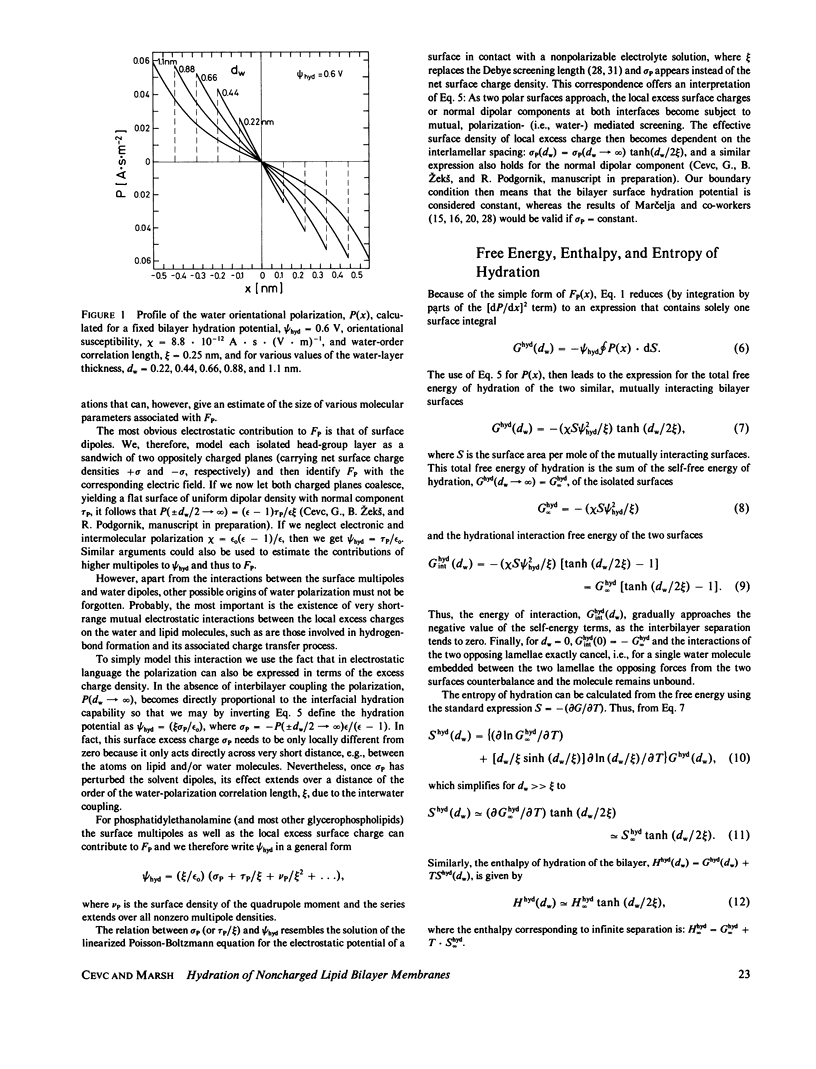
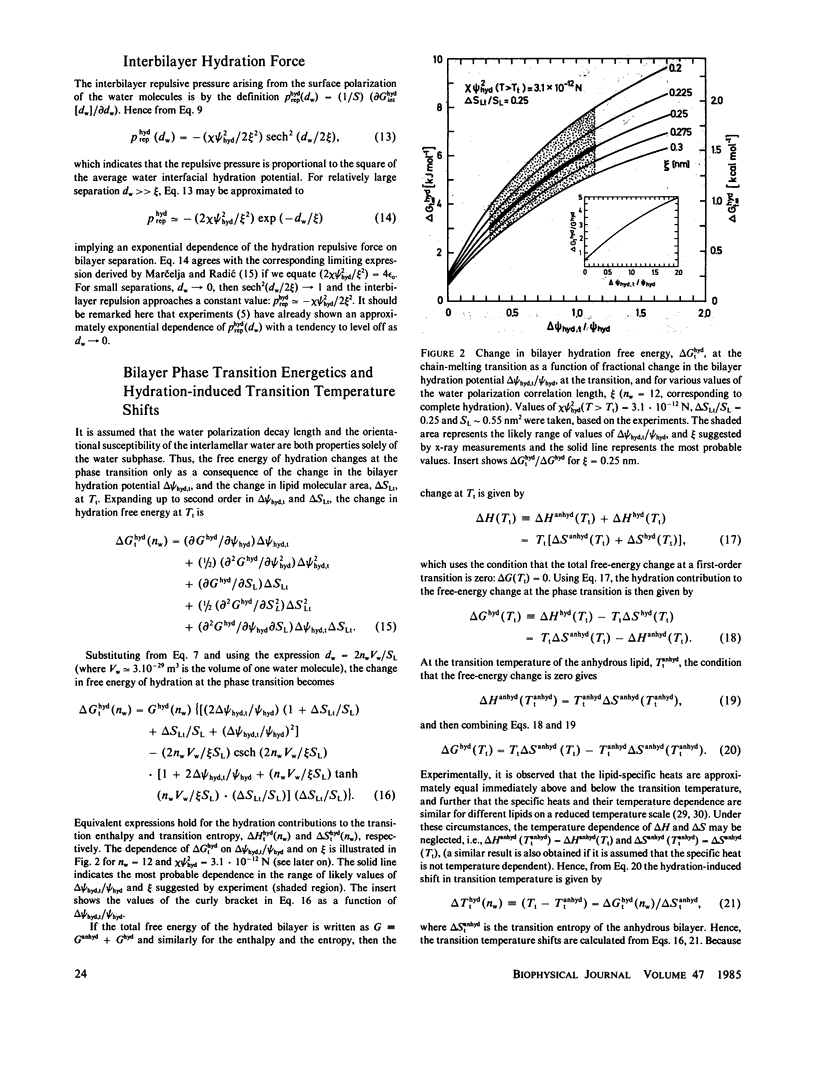

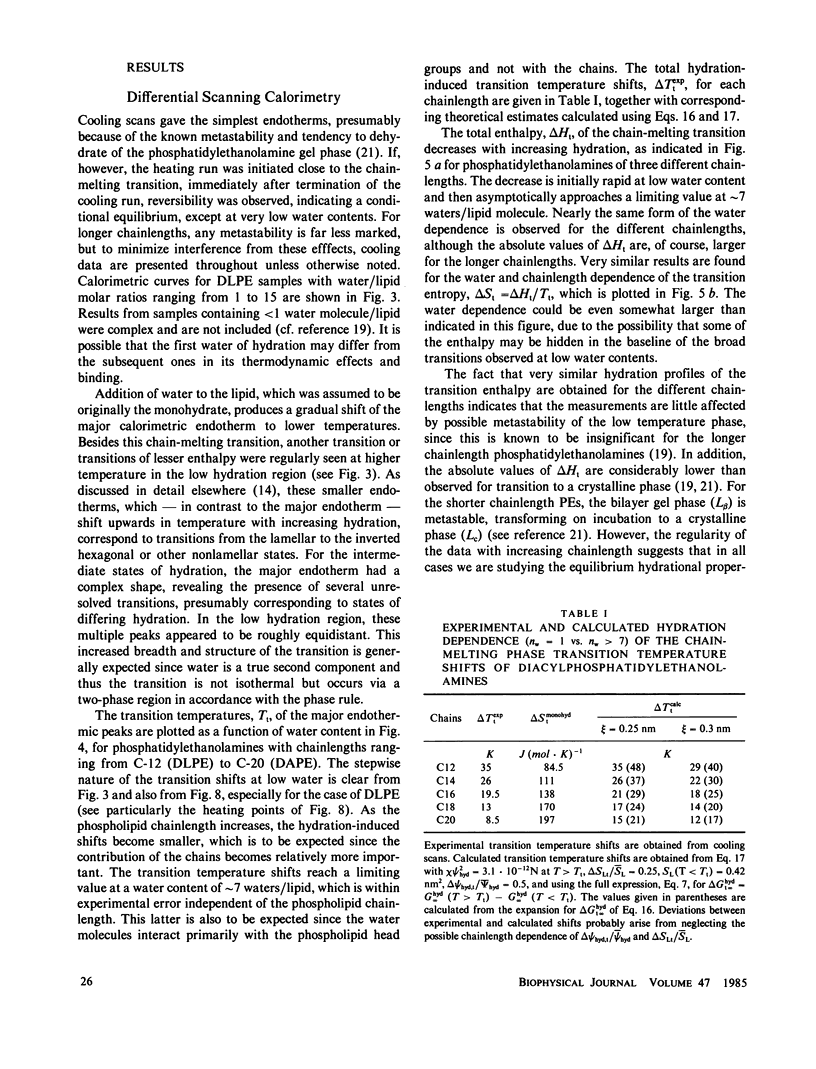
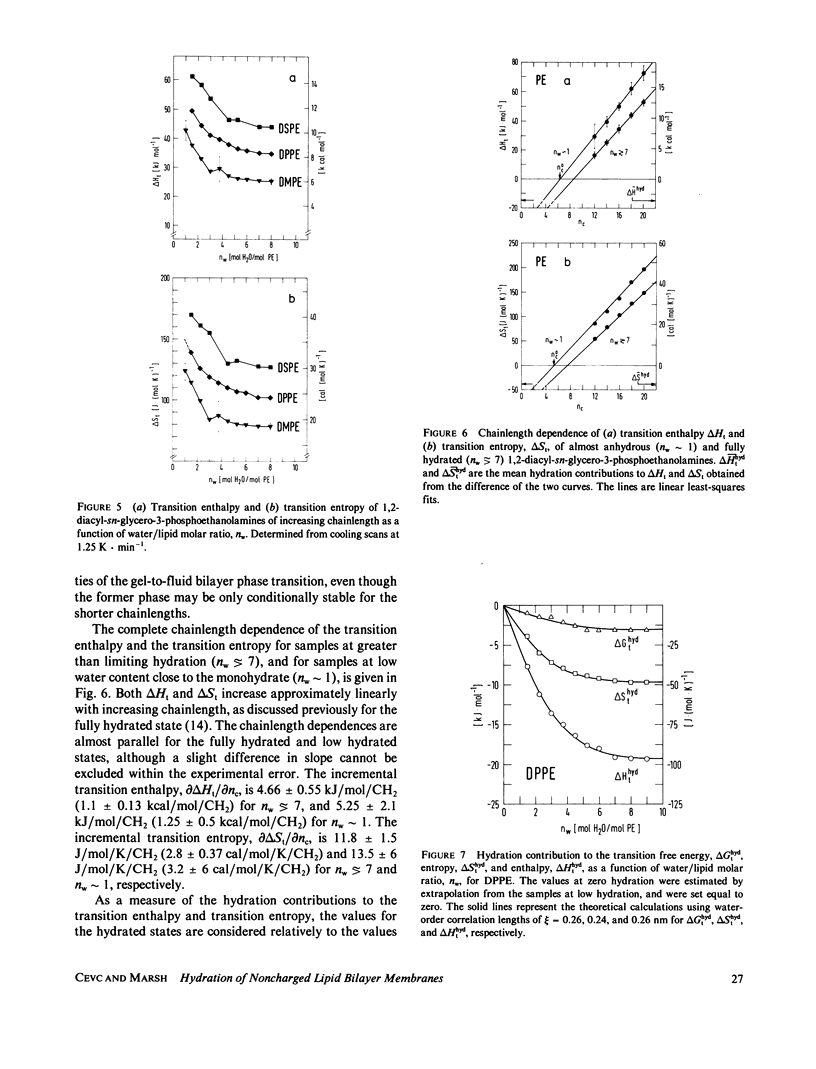


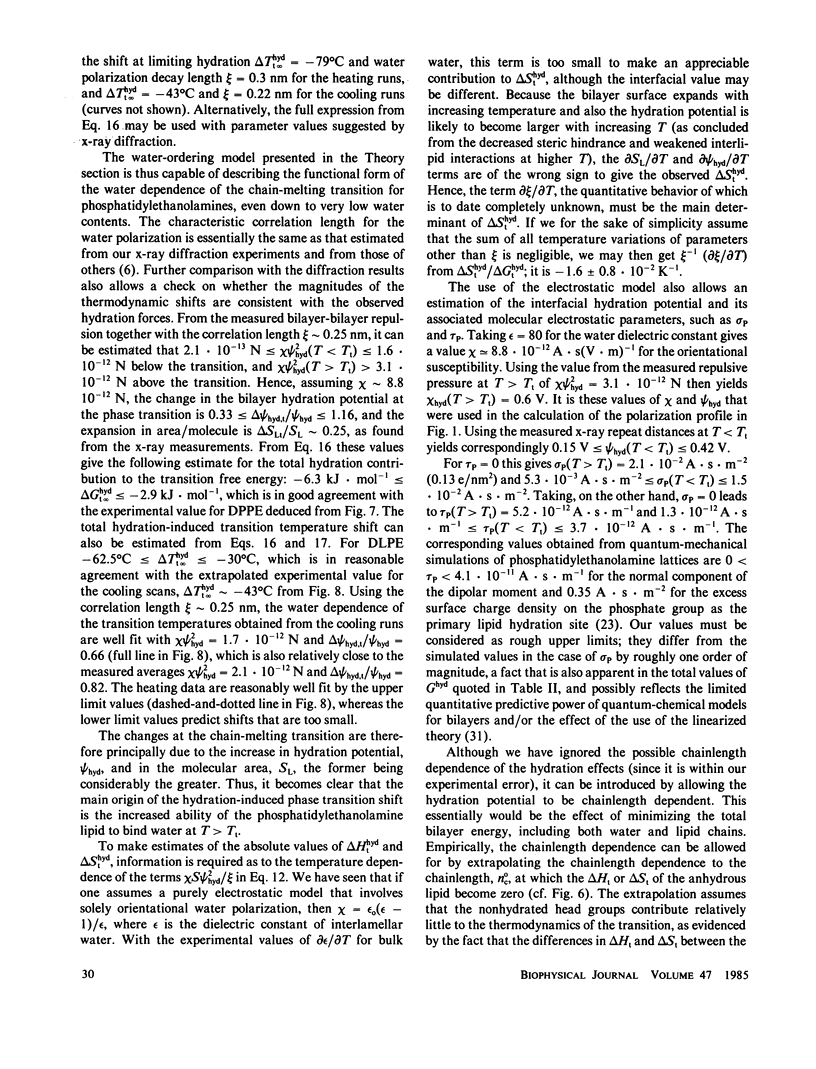
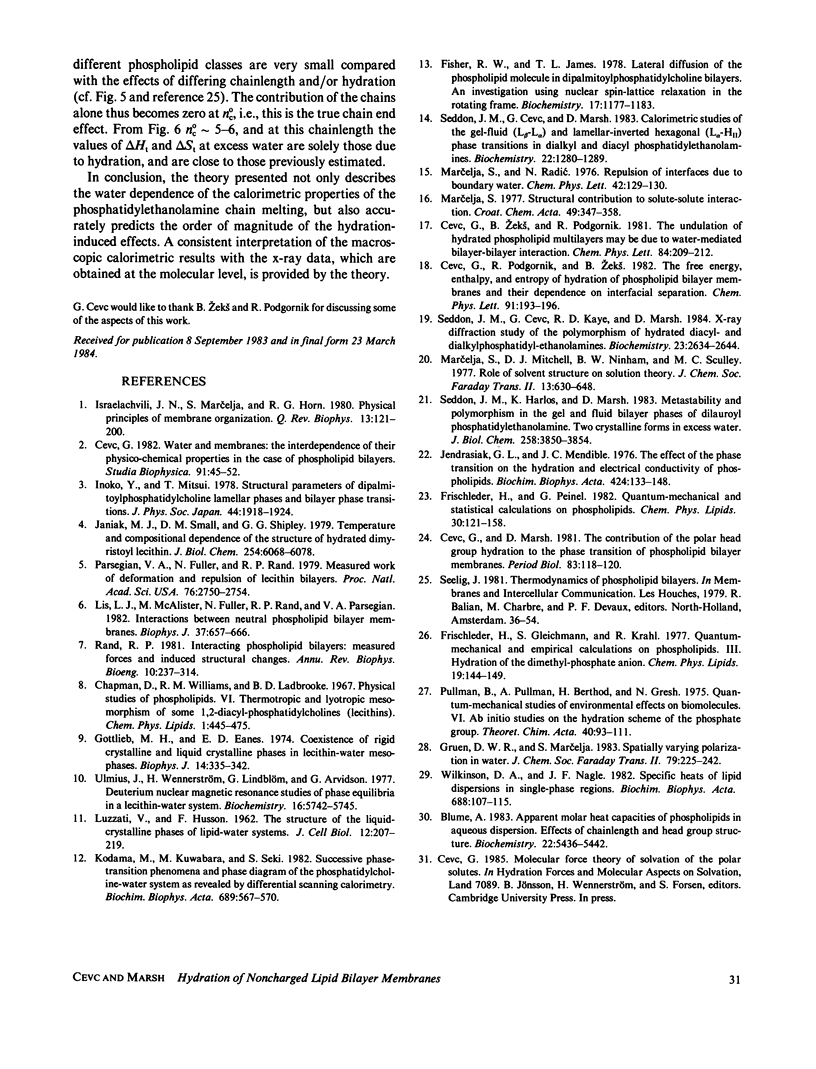
Selected References
These references are in PubMed. This may not be the complete list of references from this article.
- Fisher R. W., James T. L. Lateral diffusion of the phospholipid molecule in dipalmitoylphosphatidylcholine bilayers. An investigation using nuclear spin--lattice relaxation in the rotating frame. Biochemistry. 1978 Apr 4;17(7):1177–1183. doi: 10.1021/bi00600a007. [DOI] [PubMed] [Google Scholar]
- Frischleder H., Gleichmann S., Krahl R. Quantum-chemical and empirical calculations on phospholipids, III. Hydration of the dimethylphosphate anion. Chem Phys Lipids. 1977 Jun;19(2):144–149. doi: 10.1016/0009-3084(77)90094-9. [DOI] [PubMed] [Google Scholar]
- Gottlieb M. H., Eanes E. D. Coexistence of rigid crystalline and liquid crystalline phases in lecithin-water mixtures. Biophys J. 1974 May;14(5):335–342. doi: 10.1016/S0006-3495(74)85920-5. [DOI] [PMC free article] [PubMed] [Google Scholar]
- Israelachvili J. N., Marcelja S., Horn R. G. Physical principles of membrane organization. Q Rev Biophys. 1980 May;13(2):121–200. doi: 10.1017/s0033583500001645. [DOI] [PubMed] [Google Scholar]
- Janiak M. J., Small D. M., Shipley G. G. Temperature and compositional dependence of the structure of hydrated dimyristoyl lecithin. J Biol Chem. 1979 Jul 10;254(13):6068–6078. [PubMed] [Google Scholar]
- Jendrasiak G. L., Mendible J. C. The effect of the phase transition on the hydration and electrical conductivity of phospholipids. Biochim Biophys Acta. 1976 Feb 23;424(2):133–148. doi: 10.1016/0005-2760(76)90183-1. [DOI] [PubMed] [Google Scholar]
- LUZZATI V., HUSSON F. The structure of the liquid-crystalline phasis of lipid-water systems. J Cell Biol. 1962 Feb;12:207–219. doi: 10.1083/jcb.12.2.207. [DOI] [PMC free article] [PubMed] [Google Scholar]
- Lis L. J., McAlister M., Fuller N., Rand R. P., Parsegian V. A. Interactions between neutral phospholipid bilayer membranes. Biophys J. 1982 Mar;37(3):657–665. [PMC free article] [PubMed] [Google Scholar]
- Parsegian V. A., Fuller N., Rand R. P. Measured work of deformation and repulsion of lecithin bilayers. Proc Natl Acad Sci U S A. 1979 Jun;76(6):2750–2754. doi: 10.1073/pnas.76.6.2750. [DOI] [PMC free article] [PubMed] [Google Scholar]
- Rand R. P. Interacting phospholipid bilayers: measured forces and induced structural changes. Annu Rev Biophys Bioeng. 1981;10:277–314. doi: 10.1146/annurev.bb.10.060181.001425. [DOI] [PubMed] [Google Scholar]
- Seddon J. M., Cevc G., Kaye R. D., Marsh D. X-ray diffraction study of the polymorphism of hydrated diacyl- and dialkylphosphatidylethanolamines. Biochemistry. 1984 Jun 5;23(12):2634–2644. doi: 10.1021/bi00307a015. [DOI] [PubMed] [Google Scholar]
- Seddon J. M., Cevc G., Marsh D. Calorimetric studies of the gel-fluid (L beta-L alpha) and lamellar-inverted hexagonal (L alpha-HII) phase transitions in dialkyl- and diacylphosphatidylethanolamines. Biochemistry. 1983 Mar 1;22(5):1280–1289. doi: 10.1021/bi00274a045. [DOI] [PubMed] [Google Scholar]
- Seddon J. M., Harlos K., Marsh D. Metastability and polymorphism in the gel and fluid bilayer phases of dilauroylphosphatidylethanolamine. Two crystalline forms in excess water. J Biol Chem. 1983 Mar 25;258(6):3850–3854. [PubMed] [Google Scholar]
- Ulmius J., Wennerström H., Lindblom G., Arvidson G. Deuteron nuclear magnetic resonance studies of phase equilibria in a lecithin-water system. Biochemistry. 1977 Dec 27;16(26):5742–5745. doi: 10.1021/bi00645a014. [DOI] [PubMed] [Google Scholar]
- Wilkinson D. A., Nagle J. F. Specific heats of lipid dispersions in single phase regions. Biochim Biophys Acta. 1982 May 21;688(1):107–115. doi: 10.1016/0005-2736(82)90584-3. [DOI] [PubMed] [Google Scholar]


